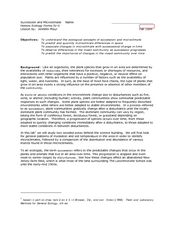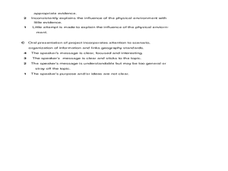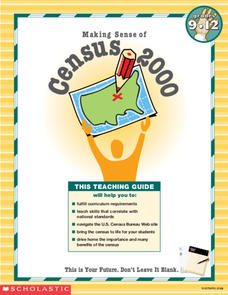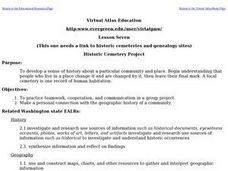Curated OER
Introduction to a Unit on the 1930's Depression in America
Learners view and discuss photographic images of the Dust Bowl by Dorothea Lange. They discuss who Dorothea Lange was and why she took the pictures, the conservational factors that contributed to the Dust Bowl and migrant workers and the...
Curated OER
Succession and Microclimate
Students compare the population of insects in different microclimates. In this biology lesson, students collect data using probes to tabulate temperature and soil data. They predict how certain parameters change as an area goes through...
Curated OER
What Is That Bubblin' In My Back Yard?
Students are introduced to the GIS system. They create a map plotting local sites the Environmental Protection Agency has on its EPA Regulated Sites list. They identify a list of schools that are near potentially hazard sites.
Curated OER
Physical Location; How a Border Town Might Develop
Students speculate how a location can develop into a large town. They investigate the physical resources and how populations can grow. There are guiding questions to help students through the research and class discussion. Students make...
Curated OER
Comparing Northwest Native American Communities
Students review how to use the database from previous lessons. Using the information, they identify the historical and environmental effects on the people living in the Pacific Northwest. They examine the various Native American groups...
Curated OER
The Arctic and Taiga Ecozone of Canada
Students examine the various sub-regions of the Arctic and Taiga zones in Canada. Using the online Canadian Atlas, they locate and describe the characteristics of each zone. They organize their information into a chart and share it with...
Curated OER
Design-a-Lesson-Packaging a Product
Students in a teacher education class address consumer related issues involving packaging. Using volume, surface area and graphs, they create a package for a given volume of a product. They design modifications for this lesson and to...
Curated OER
Home: the Story of Maine "A Love for the Land": Where Are You? Who Are You?
Students investigate their neighborhood both as it is now and as it was 100 years ago. They take a walk around their neighborhood and fill out a worksheet before completing a worksheet.
Curated OER
The Web of Life
Young scholars describe the importance of having a balance ecosystem. After a brief lecture, students give an explanation of the properties of an ecosystem. They create a web, using yarn which shows how the various members of the...
Curated OER
How We Get From Here to There
Students recognize various types of movement people rely on to get from one place to another, locate the forms of movement on a map and choose one form of movement and research its path.
Curated OER
Mapping the Village
Young scholars measure, weigh, and document the amount of trash and garbage generated by the school for one day. They brainstorm solutions for trash in the area and assist with the school-wide recycle program.
Curated OER
Growth in A City Neighborhood
Students take the "role" of city planner. They overlay a map of one area of the city in the past, present, and projected future project. Students discuss reasons for selecting the special features of the area. The activity refers...
Curated OER
Indoor Air: What's the Matter?
Students develop a greater awareness of the variety and amount of particulate matter in the air. They try to locate general sources of pollution for a specific area and develop some suggestions for improving air quality.
Curated OER
Hazard Mitigation: Bioterrorism
Students discuss different ways to spread infectious diseases. In this bioterrorism lesson, students model the rate of smoke emission using CalRoad software. They analyze the effects of airborne release of biological...
Curated OER
Contaminated Water
Middle schoolers review and use the steps in the scientific method to complete the experiment. In groups, they research the importance of water to plants and animals in their local area. They examine how water can become contaminated...
Curated OER
Making Sense of the Census
For this unit of lessons, students make sense of the census. They examine why a census is taken and partipate in activities.
Curated OER
Language Immersion
Students listen to an audio program aired on Nation Public Radio that presents a journalists report of the Blackfeet immersion programs taking place in Browning, Montana. They take notes on the program. Students discuss how immersion...
Curated OER
3-D Posters
Students work in small groups to create 3-D posters to discourage throwing trash away and encourage recycling.
Curated OER
Clean Kansas Water
Students gain an understanding of ways we can be responsible custodians of our water supply. Students explore the governor's clean water initiative involving the Lower Kansas/Republican river basin and the pollutants present there.
Curated OER
Trail Adventure
Students create a trail with numbered specimens. Students complete an accurate and functional interactive trail activity brochure. They complete a web page tree identification guide and interactive identification activity. Students...
Curated OER
Land Biomes Research and Presentation
Fifth graders work in cooperative groups to research an assigned land biome using various sources. Groups create either a book or a PowerPoint presentation of their assigned land biome.
Curated OER
Who Can Harvest A Walleye?
Seventh graders investigate the concept of how an ecosystem is put together while conducting research using a variety of resources. They correctly differentiate between a herbivore and carnivore by placing them in the order of hierarchy...
Curated OER
Historic Cemetery Project
Students use the Virtual Atlas to examine the cemetaries in the state of Washington. In groups, they view photographs of local monuments to celebrate the lives of local members. They choose one to focus on and research. To end the...
Curated OER
Discovering the Past Using the Future: Remote Sensing and the Lost City of Ubar
Learners identify and locate specific locations on the Arabian Peninsula, the Rub al Khali Desert, and present day Oman. They identify other names for the lost city of Arabia as Ubar, the Atlantis of the Sands, Iran, and the city of towers.

























